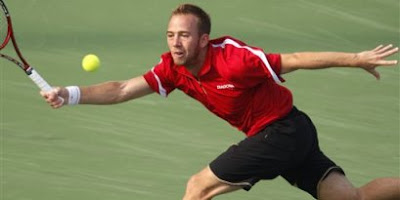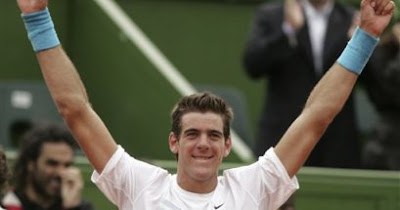 Following the excitement and drama of Davis Cup last week, it was back to business as usual on the ATP tour as some of the players made their way to Asia to play in either Beijing or Bangkok. Unlike Davis Cup, the matches that took place this week were all about the tennis, with crowds being in both tournaments being sparsely populated and players being treated to nothing more than a polite applause, although for a brief moment yesterday, Andy Roddick’s name was chanted enthusiastically by a small group of Chinese fans.
Following the excitement and drama of Davis Cup last week, it was back to business as usual on the ATP tour as some of the players made their way to Asia to play in either Beijing or Bangkok. Unlike Davis Cup, the matches that took place this week were all about the tennis, with crowds being in both tournaments being sparsely populated and players being treated to nothing more than a polite applause, although for a brief moment yesterday, Andy Roddick’s name was chanted enthusiastically by a small group of Chinese fans.This week was the start of the Asian tennis season, which briefly lasts two weeks and ends in Tokyo next week although it will be expanded from next year where Shanghai will be awarded an indoor Masters Series event. The results that took place in both tournaments were contrasting, with upsets galore in Beijing while the top four seeds navigated their way into the semi-finals stage.
Clearly the man of this week has been Dudi Sela, from Israel, who earned his way into the Beijing finals defeating the likes of David Ferrer, Tommy Robredo and Rainer Schuettler. Sela, currently ranked 92nd in the world, had previously never advanced past the quarter-finals of an ATP event. Prior to this week’s efforts, he was most known for carrying Israel into the Davis Cup world group by defeating Nicolas Massu and most notably Fernando Gonzalez in five sets.
Sela is another one of those players who has a very natural feel for the game, in a similar vein to Olivier Rochus but without the hustle and determination (or to a lesser extent anyway). His groundstrokes, which lack the necessary punch to threaten at the highest level, are fluid, effortless and difficult to read especially on his one-handed backhand. His shots rely mainly on timing, and in this particular match against Schuettler he was striking the ball particularly well, resulting in a comfortable 6-3 6-3 win over the German.
His backhand is his big weapon - he can generate numerous winners off that side or throw in a slice backhand for variety which often forced errors out of Schuettler especially in the first set. Early on in the match, I noticed Sela in one point which was being evenly contested, suddenly unleash a backhand down-the-line winner out of nowhere, completely taking Schuettler by surprise.
I watched his backhand closely to notice that Sela takes his racquet back early in preparation but has the ability to hold it before completing his swing, making it almost impossible for his opponent to read where it is going. Because of this, he was also able to increase the pace on his shots using the same backswing which allowed him to take control of points by taking his opponents by surprise. But you can also see the downside to this sort of approach because Sela can get pushed back to playing a more defensive game, or get rushed into error by a bigger hitter.
In the match against Schuettler, it was interesting to note the contrasting styles between both players. Schuettler has a fairly mechanical game in that the effort he puts in is obvious to make sure that he sets himself in the right position, and how he throws his body weight forward to try and maximize the amount of power he can generate. Schuettler generally plays a high percentage game in that he usually likes to keep the ball going crosscourt and only pulls the trigger if he sees the opportunity to do so, although he has the variety to come to the net to finish off points.
Schuettler is fairly good from a tactical point of view, and his shots are usually struck with purpose. In the second set, he tried to change the rhythm of the match by taking more risks, hitting with more pace and coming into the net more often, but it was not enough to change the outcome of the match.
Sela took a more instinctive and reactive approach to his tennis, often coming up with winners on the run, or shots that were able to turn the point in his favour. While Sela won the first set relatively comfortably with two service breaks, the first four games of the second set went on serve until Sela broke serve with a flourish, first firing a forehand winner down-the-line on the run, then two lobs over Schuettler’s head to take control of the match. By the end of the match, Schuetttler’s frustration became obvious as he began to talk to himself, knowing that he had run out of ideas.
Sela next meets Andy Roddick in the final, who proved too solid for Bjorn Phau, winning 6-2 6-7 6-1. Phau plays most of his tennis at the Challengers level, and it was interesting to note the difference between the two in this match. It looked like Roddick, one of the most energetic players on tour, was playing on autopilot most of the time playing his usual game, taking care of his service games in an efficient manner and hitting reliable, consistent and heavy groundstrokes.
The match featured many extended rallies, where Phau, the lower ranked player was the one trying to make things happen, maybe going out of his comfort zone. For those who watched Phau’s performance against Rafael Nadal in the first round of this year’s US Open will know that Phau is a clean striker of the ball, and incredibly quick around the court. He is solid on both wings, but more so on the backhand side which is clearly his favoured side. He must be one of the few players with a one-handed backhand that runs around his forehand to hit a backhand on shots that land down the middle.
In the first set, Phau was targeting Roddick’s backhand too often, not making Roddick move enough and found himself paying the price for coming to the net too early as he got passed time and time again. Phau adopted a more aggressive approach in the second set trying to hit closer to the lines and changing directions more often, and importantly he was having more success at the net.
Both players held serve with relative ease in the second set. The crucial mini-break in the second set came when Roddick stuck his racquet out to volley a shot that was going potentially wide, and that was enough for Phau to take the set. The third set continued in the same vein for the first two or so games, until Roddick broke Phau’s serve on an extended game that featured four or so deuce points. Phau’s game quickly dropped off after that as Roddick cruised to a 6-1 victory in the third set.
Elsewhere in Bangkok, fans will be treated to an Australian Open final re-match between Novak Djokovic and Jo-Wilfried Tsonga after both players defeated their respective opponents in the semi-finals, Tomas Berdych and Gael Monfils. The match between Monfils and Tsonga, was a disappointing encounter as Tsonga cruised his way to a 6-0 6-3 victory against a sluggish Monfils. Tsonga, however, showed some good form, with both his serve and forehand firing nicely, and kept his errors down to a minimum which is the main measuring stick for him in terms of his form.






